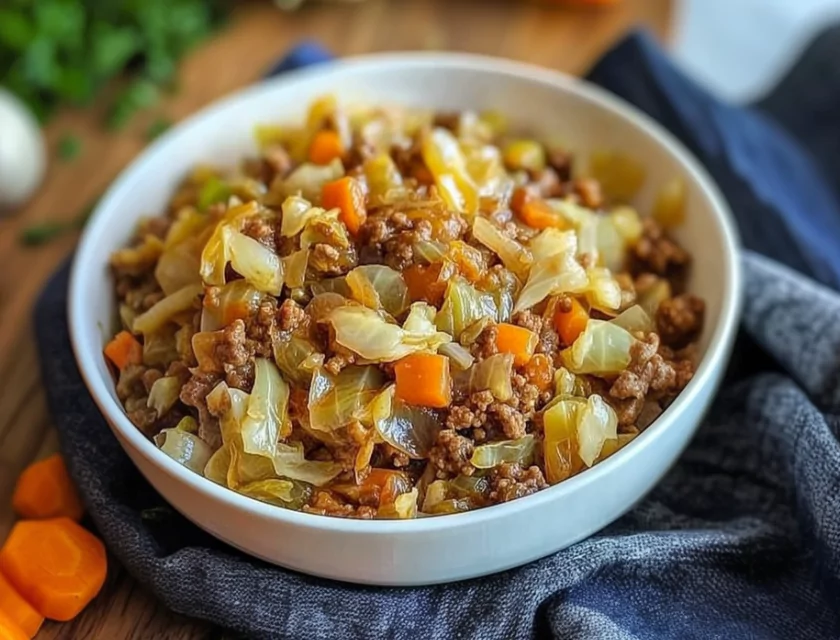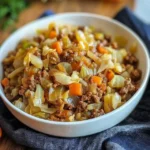There’s something undeniably comforting about a hearty, home-cooked skillet meal. The ground beef and cabbage skillet combines the rich flavors of savory beef with the crisp texture of fresh vegetables. This dish is not only flavorful but also easy to prepare, making it perfect for busy weeknights or weekend meal prep sessions.

Whether you’re following a low-carb, keto, paleo, or gluten-free diet, this recipe checks all the boxes. Packed with protein, loaded with fiber-rich veggies, and brimming with bold flavors, it’s a dish that feels indulgent while keeping health in mind.
This guide will walk you through everything you need to know to prepare this versatile dish. From selecting the right ingredients to step-by-step cooking tips, you’ll gain the confidence to create a skillet meal your family will ask for again and again.
Overview of the Recipe
The ground beef and cabbage skillet is the epitome of simplicity. It uses pantry staples, fresh vegetables, and a handful of seasonings to create a dish that’s bursting with flavor. Plus, with only one pan required, cleanup is a breeze.
This dish stands out because of its adaptability. You can swap out ingredients based on your preferences or what’s in your fridge. Don’t have carrots? Use zucchini or mushrooms. Want a spicier version? Add a dash of sriracha or crushed red pepper flakes.
Brief History and Cultural Significance of Similar Skillet Meals
Skillet meals have been a staple in kitchens worldwide for centuries. The idea of combining meat and vegetables in one dish is not new—it has roots in cuisines from Europe, Asia, and the Americas.
- European Influences: In Central and Eastern Europe, cabbage is often paired with ground meat in dishes like stuffed cabbage rolls or stir-fries.
- Asian Inspiration: The use of soy sauce or coconut aminos in this dish nods to the stir-fry tradition found in Chinese and Southeast Asian cooking. These recipes often emphasize quick cooking methods and fresh ingredients.
- American Comfort Food: Skillet dishes became a hallmark of American households during the mid-20th century. With their simplicity and versatility, they offered a way to stretch ingredients and create wholesome meals.
The ground beef and cabbage skillet takes inspiration from these global influences, combining them into a dish that’s accessible, delicious, and endlessly customizable.
Preparation Phase and Tools to Use
Essential Tools and Equipment
- Large Skillet or Wok: A 12-inch skillet works best to ensure even cooking and enough space to toss the vegetables.
- Spatula or Wooden Spoon: These tools make it easy to break up the beef and stir the ingredients.
- Sharp Knife and Cutting Board: Precision is key for slicing the cabbage, bell pepper, and green onions.
- Measuring Spoons: To ensure accuracy when adding seasonings and liquids.
Preparation Tips
- Preheat Your Pan: Allow your skillet to heat up before adding oil or ingredients. This step ensures the beef browns evenly without steaming.
- Slice Vegetables Uniformly: To promote even cooking, aim for consistent sizes when cutting cabbage, carrots, and bell peppers.
- Don’t Overcrowd the Skillet: If you’re doubling the recipe, cook the beef in batches to maintain proper browning.
- Prep Ingredients in Advance: Chop all your vegetables and measure out your spices before you start cooking. This makes the process smoother and less stressful.
Ingredients List
Primary Ingredients:
- ½ tablespoon extra virgin olive oil
- 1 pound ground beef
- ½ teaspoon minced ginger
- 1 teaspoon garlic powder
- 1 teaspoon onion powder
- 1 teaspoon chili powder
- 1 teaspoon ground black pepper
- 1 teaspoon coconut sugar
Vegetables:
- ½ large head of green cabbage, sliced
- 1 red bell pepper, thinly sliced
- 1 cup shredded carrots
- 3 green onions, chopped
Seasonings and Garnishes:
- 3 tablespoons coconut aminos (or tamari/soy sauce)
- 1 tablespoon apple cider vinegar
- Sesame seeds, for garnish
Step-by-Step Cooking Instructions
1. Heat the Skillet
Place a large skillet over medium-high heat. Add the olive oil and allow it to heat until it shimmers. This ensures the beef browns properly, creating a rich base flavor for the dish.
2. Cook the Ground Beef
Add the ground beef and minced ginger to the skillet. Break the meat into smaller pieces using a spatula as it cooks. Stir occasionally, cooking for about 5 minutes or until the beef is mostly browned.
3. Add Seasonings
Sprinkle the garlic powder, onion powder, chili powder, black pepper, and coconut sugar evenly over the beef. Stir well to combine, ensuring the spices coat the meat evenly. Cook for another minute, letting the spices bloom and become fragrant.
4. Add the Vegetables
Toss in the sliced cabbage, red bell pepper, shredded carrots, and chopped green onions. Gently mix everything together to distribute the vegetables evenly with the beef. Reduce the heat to medium and let the mixture cook for 5-7 minutes. Stir occasionally to prevent sticking, allowing the vegetables to soften but still retain some texture.
5. Incorporate Coconut Aminos
Pour the coconut aminos (or tamari/soy sauce) over the skillet mixture. Stir to combine and let the flavors meld for 1-2 minutes. This step enhances the dish with a savory, slightly sweet flavor profile.
6. Add Apple Cider Vinegar and Finish
Drizzle the apple cider vinegar over the skillet mixture and give it a final stir. Turn off the heat and let the residual warmth of the pan distribute the vinegar evenly, adding a bright, tangy finish.
7. Garnish and Serve
Transfer the skillet contents to a serving dish or plate directly from the pan. Sprinkle sesame seeds on top as a garnish, adding a nutty crunch to every bite. Serve hot and enjoy!
This preparation process ensures that each step builds flavor while keeping the vegetables vibrant and fresh. It’s an uncomplicated method that yields extraordinary results.
Side Dish Recommendations
The ground beef and cabbage skillet is a satisfying dish on its own, but pairing it with the right side dishes can elevate the meal even further. Here are eight delicious options that complement the flavors and textures of this hearty skillet:
- Garlic Butter Rice
- The rich, buttery flavors of garlic-infused rice provide the perfect neutral base for soaking up the savory sauce from the skillet.
- Roasted Sweet Potatoes
- Sweet potatoes add a natural sweetness that balances the umami flavors of the beef and cabbage. Roast them with olive oil, paprika, and cinnamon for a touch of spice.
- Simple Mixed Greens Salad
- A crisp salad with a light lemon vinaigrette provides a refreshing contrast to the warm skillet. Toss in some cherry tomatoes, cucumbers, and sliced radishes for extra crunch.
- Cheesy Cauliflower Mash
- For a low-carb option, pair this skillet with creamy cauliflower mash. Add a touch of parmesan or cheddar cheese for richness.
- Buttered Egg Noodles
- Simple egg noodles tossed in butter and parsley offer a comforting, kid-friendly side.
- Steamed Broccoli with Lemon
- Steamed broccoli lightly dressed with lemon juice and olive oil adds a bright, zesty note to the meal while boosting its nutritional profile.
- Crusty Bread or Dinner Rolls
- A warm, crusty bread or soft dinner roll is perfect for scooping up every last bite from the skillet.
- Spicy Kimchi
- For an Asian-inspired twist, serve with a side of spicy kimchi. Its tangy, fermented flavors pair beautifully with the cabbage and beef.
Nutritional Information and Health Benefits
This ground beef and cabbage skillet is not just delicious; it’s packed with nutrients that make it a healthy choice for any meal. Here’s a closer look at the health benefits of the key ingredients:
- Ground Beef
- Rich in protein, iron, zinc, and B vitamins, ground beef supports muscle growth, energy production, and overall health. Opt for lean ground beef to reduce saturated fat content.
- Cabbage
- A powerhouse of nutrients, cabbage is loaded with vitamins C and K, fiber, and antioxidants. It promotes digestive health, supports a healthy immune system, and helps reduce inflammation.
- Carrots
- Carrots are an excellent source of beta-carotene, which the body converts to vitamin A for healthy skin, vision, and immune function.
- Red Bell Pepper
- Packed with vitamin C, red bell peppers boost immunity and support collagen production. They also add a subtle sweetness and vibrant color to the dish.
- Coconut Aminos
- A gluten-free alternative to soy sauce, coconut aminos are lower in sodium and contain beneficial amino acids.
- Apple Cider Vinegar
- Known for its potential to improve digestion and stabilize blood sugar levels, apple cider vinegar adds a tangy brightness to the dish.
This skillet meal is also a great choice for low-carb and keto diets, as it is naturally low in carbohydrates and high in fiber and protein. It’s filling without being heavy, making it ideal for anyone looking to maintain a balanced diet.
Common Mistakes to Avoid & How to Perfect the Recipe
Even a simple dish like the ground beef and cabbage skillet can go wrong if a few common pitfalls aren’t avoided. Here’s how to perfect this recipe every time:
1. Overcooking the Vegetables
- Mistake: Cooking the vegetables too long can make them mushy and leach out their vibrant colors.
- Solution: Cook the cabbage and other vegetables just until they’re tender but still have a slight crunch. Monitor the heat and stir often to ensure even cooking.
2. Using Too Much Oil
- Mistake: Adding excessive oil can make the dish greasy and mask the flavors of the other ingredients.
- Solution: Stick to the recommended amount of olive oil. If you need to prevent sticking, add a splash of water or broth instead of more oil.
3. Skipping the Browning Step
- Mistake: Failing to brown the ground beef can result in a bland dish with less depth of flavor.
- Solution: Allow the ground beef to brown fully before adding the spices. Don’t overcrowd the skillet, as this can cause the beef to steam rather than sear.
4. Adding Soy Sauce Too Early
- Mistake: Adding coconut aminos (or soy sauce) too early in the cooking process can result in a salty, overly reduced sauce.
- Solution: Add the coconut aminos toward the end of cooking to preserve its flavor and avoid over-reducing.
5. Not Adjusting Seasonings
- Mistake: Assuming the seasonings are perfect without tasting.
- Solution: Always taste the dish before serving and adjust salt, pepper, or acidity (with more apple cider vinegar) as needed.
6. Choosing the Wrong Skillet Size
- Mistake: Using a small skillet can make it difficult to stir the ingredients properly, leading to uneven cooking.
- Solution: Use a 12-inch skillet or larger to ensure there’s enough room for all the ingredients.
7. Forgetting Garnishes
- Mistake: Skipping the sesame seeds might seem minor, but they add a delightful crunch and nutty flavor.
- Solution: Always finish the dish with sesame seeds or an alternative garnish like chopped cilantro or parsley.



Leave a Comment